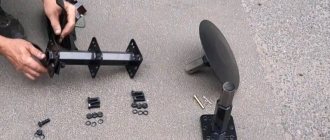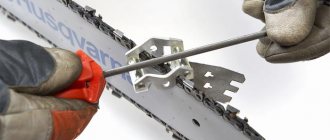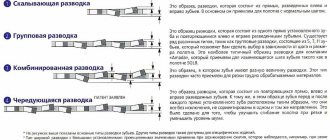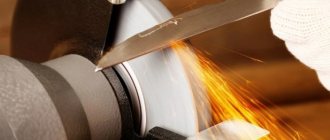Choosing and purchasing a manicure tool is only half the battle, since it requires constant and high-quality maintenance and sharpening. New scissors or forceps can become dull after just a few uses, and some need to be brought into good working condition immediately after purchase. It all depends on the quality of the metal and the initial characteristics of the tool. What does a manicurist need to know about sharpening manicure tools? Is it possible and how to sharpen nail scissors, tongs and cutters at home? How to evaluate and accept a job in the service? Let's look at all the questions in order.
Types of sharpening
There are two directions:
- Conveyor or factory processing
- Manual sharpening
The factory one is of lower quality and often the sharpness is lost after the first 10-15 uses. Even if the blades are initially very sharp, they dull much faster compared to manual processing. Also, the blades may have different sharpness along the length, which is why forceps or scissors tear the cuticle and leave burrs.
Sharpening by hand requires experience, knowledge and skill. It is better to contact a professional in the workshop to get the desired result. Many craftsmen try to sharpen scissors and pliers at home using improvised tools. Yes, perhaps the sharpness will be enough for a couple more procedures, but after that it is still lost, and the service technician has to do more work to eliminate the consequences of home sharpening.
What professional equipment is used for sharpening manicure tools?
Where can you sharpen nail scissors, tweezers, and cutters if you have given up on home experiments and decided to entrust the tools to a professional? There are special workshops that carry out maintenance of manicure equipment.
On average, the cost of such a procedure starts from 300 rubles, and varies depending on the city and country of residence. Many craftsmen in big cities complain that the cost of the service is almost comparable to the purchase of new tools, but this is only if you compare inventory of low and medium price categories. If you are working with high quality products, it is better not to take risks and contact a workshop.
There are two types of professional sharpening machines:
- Mechanical
- Laser
The first ones are equipped with a diamond-coated metal grinding wheel, which, when rotated, grinds down the edges of the tools, giving them the desired sharpness. The method keeps the tool durable and does not shorten the service life.
A laser machine is easier to use, but it wears down the metal faster, making it more fragile. Where to sharpen manicure tools after this? Of course, where the craftsman does it with a high level of quality, regardless of what machine is used.
Machine device
hairdressing tools sharpening machine
A sharpening machine is an electric motor with a shaft onto which a faceplate and a sharpening disk are mounted. There are two types of machines: with a horizontal faceplate and a vertical one. The former are convenient for working with almost any type of surgical, hairdressing and manicure instruments.
The most technologically advanced equipment models are equipped with a laser “sight” or a manipulator that helps set the sharpening angle of drills. Even a beginner can cope with a complex and painstaking procedure on such a machine. You can also set the disk speed that is optimal for each specific tool.
The transparent protective visor prevents harmful dust from flying away and protects the technician. High-quality equipment is produced in Germany and the USA and is quite expensive. The cheapest machine without a manipulator will cost approximately 45 thousand rubles.
The peculiarity of equipment for sharpening hairdressing and manicure instruments is the increased mechanical requirements. The runout of the spindle on which the faceplate is mounted is completely eliminated. The abrasive surface must move perfectly in the plane, otherwise the required accuracy cannot be achieved. Acceptable runout standards are indicated in the passport and are no more than 0.11 with a sharpening disc on.
In the workshop, the machine works all day, so the speed and quality of the work depends on the accuracy of rotation of the faceplate with the attached grinding disc. High-quality equipment operates for a long time without wear of rubbing and moving mechanisms and bearings.
Technical characteristics of the machines:
- Dimensions: this is a mobile desktop equipment;
- reverse: a useful option for finishing many tools;
- disc sizes: from 150 to 240 mm;
- rotation speed adjustment up to 3 thousand revolutions per minute;
- electric motor: in this case, power is not so important, so it usually does not exceed 300 W, but they are characterized by quiet operation and do not overheat due to ventilation;
- machine weight: about 30 kg.
The kit includes spare abrasive discs, a wheel and polishing paste. The legs are equipped with rubber pads that dampen vibration.
Basic rules for sharpening tools
There are several key points that make up the algorithm for servicing manicure equipment. If all points are completed, we get the desired result.
- When closing scissors, forceps or cutters, nothing should prevent the handles from coming together. If such a problem arises during work, they must be taken to the workshop and all interfering or protruding parts must be ground off on the machine. At home, you can do this with a sharpening stone or rasp, being careful.
- Nippers, cutters and scissors should not dangle, there should be no gap between the cutting planes and at the point of connection of the handles.
- The cutting planes of the nippers should be smooth and close without gaps under gentle pressure.
- The convergence of the cutting edges in the nippers should be uniform from one edge to the other, and not wavy: first the tip, and then the heel, or vice versa.
- The blades should not have protrusions or burrs that catch, scratch or cut the skin.
- The outer edge of the pusher should be sharper than the inner one, and the inner one should have a straight line without jagged edges. The main task of the tool is to move the skin, not cut it.
When sharpening, all factors must be met to obtain the desired result.
Sharpening of pliers, skin tongs, tweezers. If the cutters are loose, they are stuffed at the junction of the blades. They should walk softly and close in an even line. The inside of the nippers is ground down to a straight line from the inside. When closing, the blades should be in the same plane, neither higher nor lower than one another. If there are burrs on the tips of the cutters, they need to be sanded down.
Nippers for manicure and pedicure - types, brands, selection criteria and operating rules
Sharpening pushers.
After processing, they should be sharp, but not cut the skin. They should also not scratch the nail. If the pusher falls and bends, the edge is leveled and then ground down. The pusher is always sharpened on the outside, and only polished on the inside. It is necessary to ensure that the outer edges are not sharp; they should also be ground and sanded.
Types of pushers - comparison, characteristics, operating rules
Sharpening nail scissors.
If the blades were deformed after a fall, the edge will have to be ground down. If the damage is significant, then most often the scissors cannot be repaired. If the deformation is small, then grinding helps eliminate it, but the length of the blades will be reduced.
When sharpening scissors, only the front surface is removed. You cannot go into the rear one; it was processed only once at the factory, and this is enough for the entire operating cycle. After each grinding of a layer, it is necessary to remove the metal grain from the blades so as not to damage them when closing.
Nail scissors - types, proper use, choosing the best
The sharpening angle of the scissors must correspond to the factory rake angle and cannot be changed. Usually it is 60-75°.
At the final stage, it is recommended to go over the blades with fine-grained sandpaper to remove burrs.
Sharpening manicure knives.
They are used mainly for pedicures, to remove rough skin and corns. The manicure knife should not be very sharp; the factory angle should be maintained and the edge should not be ground into a bayonet.
Questions and answers
Besides sharpening tools, what can you do on sharpening and grinding machines?
In addition to sharpening cutting surfaces, such machines can: process forged parts, clean the surface of various types of materials, polish glass products, etc.
Is it possible to avoid overheating of the blade of a cutting tool when sharpening it?
Avoid heating the blades of cutting tools when sharpening them on machines equipped with water tanks. Grinding discs are immersed in it during operation.
What models of sharpening machines can be used for professional use?
For professional work, you can use TSh-1.10, ZVS-20 machines.
How can you clean the aluminum oxide wheels of a sharpening machine quickly and efficiently?
The wheel is cleaned with a carborundum block.
Why are transparent protective screens installed on the body of grinding machines?
Protective screens prevent the spraying of metal dust when sharpening tools.
How and with what to check the sharpening level
Even a professional manicure cannot be done with a blunt instrument. That is why regular maintenance of tongs, scissors, and tweezers is necessary. With a large flow of clients in the salon, maintenance of scissors and cutters may be required once every two to three weeks. With a lower flow - much less often.
To understand when it's time to sharpen your manicure tools, there are a number of simple tests. They will require the following materials to choose from:
- Thin plastic bag
- Stretch film
- Dried wet wipe made of non-woven material
- Elastic vinyl, latex or nitrile gloves
These same tests will allow you to check the quality of the work performed by the master. In the workshop, these tests are used to check each of the processing stages of blades and cutting edges.
Methods and instructions on how to check the quality and level of sharpening:
- We fix the thin plastic bag so that the edge is even. Unclench the scissors, tongs or wire cutters, place the edge of the bag between them, and close along the entire length. The blades should not tear, snag or pull the polyethylene.
- Stretch film is the most demanding material for checking the level of sharpening. The principle is the same - we fix the film and close the blades along its entire length. The cut should be smooth.
- A napkin made of non-woven material demonstrates well the presence of burrs on metal. With high-quality processing, the cut is smooth, without snagging on the blade.
- Vinyl or nitrile gloves should be secured between the thumb and forefinger, the cutting edges should be completely opened and closed, placing the glove sheet between the blades, and then pulled down slightly towards you. Often scissors or tongs cut well at the base, but the closed edge pulls the glove and tears it. This means it's time to sharpen the blades again.
Proper sharpening of manicure tools at home
How to sharpen manicure tweezers, scissors and nippers at home? This can be done at home using a grinding wheel or by hand. If you don't have experience with this, it's better to ask someone who has tried it or knows how to do it. Otherwise, you need to take the manicure tools to the workshop.
If you still decide to carry out the procedure at home, you will need:
- Sharpening stone or rasp
- Sandpaper, hard and sanding
- Any of the above materials to check the level of sharpening
A block or rasp is suitable for processing large areas. They should work smoothly, respecting the factory angles. Next, the blades are sanded with sandpaper. It can be secured with tape to the handle of a spoon or a wide nail file for additional support.
You can get by with just sandpaper, first 600 grit and then 1500 grit, to smooth out any burrs on the metal.
Some craftsmen use foil folded in 4-8 layers, finely cutting it with a tool to the desired degree of sharpening. Reviews about this method are mixed, so if you have an expensive, high-quality instrument, it’s better not to risk it.
Everyone should mind their own business, and if possible, it is better to have the tools serviced by a professional. If you decide to do the treatment at home, follow all recommendations.
What should you consider when choosing a sharpening machine?
When purchasing equipment, its performance, purpose and power are taken into account. Its ability to carry out the volume of planned work depends on these indicators.
It is important what kind of grinding wheels the machines are equipped with. If they are not available for sale, the equipment will be useless.
Other factors determining the choice of machine include:
- type of instalation;
- availability of additional functions;
- manufacturer;
- sharpening angles;
- method of fastening the tool being processed;
- price.











